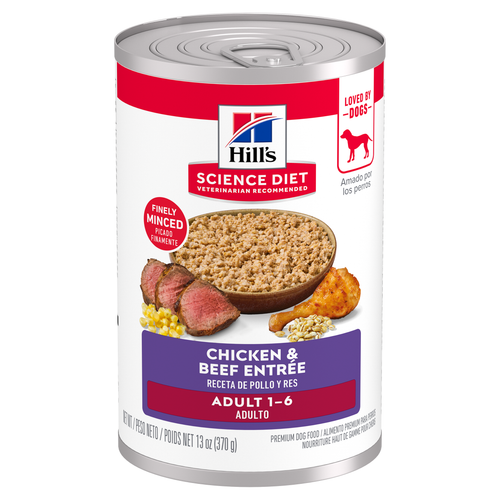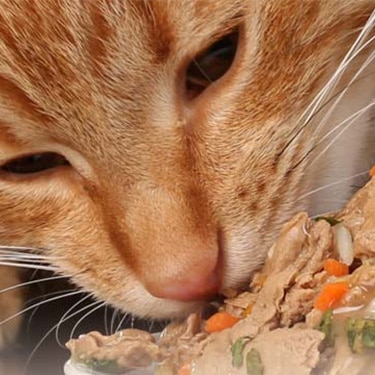
-
Find the right food for your petTake this quiz to see which food may be the best for your furry friend.Find the right food for your petTake this quiz to see which food may be the best for your furry friend.Featured products
 Hill's Science Diet Adult Chicken & Beef Entrée Dog Food
Hill's Science Diet Adult Chicken & Beef Entrée Dog FoodChicken & Beef Entrée in a delicious loaf with complete & balanced nutrition to help keep adult dogs active and healthy
Shop Now Adult Large Breed Chicken & Barley Recipe Dog Food
Adult Large Breed Chicken & Barley Recipe Dog FoodSupports healthy joints, lean muscle, and beautiful coat for large breed dogs
Shop Now Adult Chicken & Barley Recipe Dog Food
Adult Chicken & Barley Recipe Dog FoodSupports lean muscle and beautiful coat for adult dogs
Shop NowFeatured products Senior Vitality Adult 7+ Tuna & Vegetables Stew
Senior Vitality Adult 7+ Tuna & Vegetables StewImproves Everyday Ability to Get Up & Go
Shop Now Adult Tender No Corn, Wheat, Soy Chicken & Vegetables Stew Cat FoodShop Now
Adult Tender No Corn, Wheat, Soy Chicken & Vegetables Stew Cat FoodShop Now Adult Turkey & Liver Entrée Cat Food
Adult Turkey & Liver Entrée Cat FoodPrecisely balanced nutrition with the delicious taste of minced turkey & liver to help fuel the energy needs of cats during the prime of their life
Shop Now -
Dog
- Dog Tips & Articles
-
Health Category
- Weight
- Food & Environmental Sensitivities
- Urinary
- Digestive
- Joint
- Kidney
-
Life Stage
- Puppy Nutrition
- Adult Nutrition
- Senior Nutrition
Cat- Cat Tips & Articles
-
Health Category
- Weight
- Skin & Food Sensitivities
- Urinary
- Digestive
- Kidney
-
Life Stage
- Kitten Nutrition
- Adult Nutrition
Featured articles What Is Littermate Syndrome? Pet Adoption Guide
What Is Littermate Syndrome? Pet Adoption GuideLearn more about littermate syndrome in dogs and cats and how to successfully navigate adoption and early socialization processes.
Read More How to Properly Mix Wet & Dry Pet Foods
How to Properly Mix Wet & Dry Pet FoodsAn Orange cat eating from a bowl filled with mixed food
Read More The Science Behind Our Love for Pets
The Science Behind Our Love for PetsLearn the scientific reasons why we have such strong connections with our pets, and what science says about the love between humans and our furry friends.
Read More -


After joining a telehealth visit with your physician, you may be wondering if there are virtual vet appointments for your pets — and there are! It's just a matter of determining whether a virtual visit would suffice or if a visit to your local veterinarian's office is required.
Use this guide to determine when it would be best to talk to a vet online, what to expect and how to prepare.
What to Expect
Virtual tools are used to conduct a telehealth veterinary visit. There are many different options for connecting, with some of the most popular being apps that allow you to directly message your veterinary team or schedule a video conference appointment instead of being seen in person.
Direct messaging is as simple as it sounds. This allows pet parents to talk to a vet online through instant messaging or by uploading pre-recorded videos or pictures for the vet to review. Virtual vet appointments are also simple! Pet parents can schedule appointments that will take place via video conferencing. There's no specific time frame for these appointments; some may last only five minutes while others may take an entire hour. The appointment time will be dependent on the need — just like they are for in-person visits.
 However, there are some differences between in-office appointments and virtual ones. Most obviously is that your pet won't get a "hands on" experience. Your vet won't be able to weigh your pet or physically examine them. The veterinarian can only listen to your description of signs and perform a visual examination from what they can see via the video camera.
However, there are some differences between in-office appointments and virtual ones. Most obviously is that your pet won't get a "hands on" experience. Your vet won't be able to weigh your pet or physically examine them. The veterinarian can only listen to your description of signs and perform a visual examination from what they can see via the video camera.
Claudine Sievert, a DVM from Kansas and veterinary consultant at CatPet.club, explains, "An online visit means that the vet cannot do a full clinical examination. The vet cannot see the color of the mucosa (or gum / inside of lip); they cannot palpate the animal or auscultate the lungs. This can be challenging if the pet parent wants a final diagnosis. That is why many times online vets can give you advice regarding the pet's condition, but not the final diagnosis." This means your veterinarian cannot use a stethoscope to listen to your pet's lungs or heart and cannot feel that lump that you might be describing. Additionally, they cannot administer a medication or a vaccination.
What Types of Visits Qualify?
If you're interested in having your pet examined virtually, you may be unsure of what type of appointments would qualify for a virtual vet visit.
Qualifying Appointments
Pet parents may choose to meet virtually with their vet for checkups and follow-up appointments.
Sievert says that pet parents "with a pet-related problem can seek advice or a second opinion. The vet can advise about nutrition, breeding, treatments, surgical procedures, vaccination protocols, external and internal parasite prevention and more. The vet can also give their opinion concerning clinical signs and possible health conditions."
Still unsure whether your needs qualify for a virtual vet visit? Quite often, your vet or their office staff will be able to help you understand whether a virtual or an in-person appointment is needed. Some veterinary offices will require a phone screening, or they may use an app that will allow you to chat with the office staff and upload pictures before scheduling an actual virtual appointment.
Sievert also shares, "If an online vet estimates that the condition is too critical, they will advise the pet parent to go to the emergency vet clinic."
When to Seek Emergency Care
Whether you use your own decision-making or rely on a conversation with the veterinarian to make a choice, some visits will require emergent care, and you'll want to head to an emergency clinic immediately.
Sievert suggests seeking emergency treatment in the following situations:
Persistent bleeding for more than 10 minutes
Car accidents, which can cause internal bleeding
Seizures of any kind
Difficult labor or prolonged labor in a pregnant dog
Bloated abdomen or stomach
Persistent vomiting, which may be a sign of a poisoning
Unusual, heavy breathing or difficulty breathing
This list does not cover all possible emergencies, so if you think your pet may need emergency care, always err on the side of caution and seek treatment. If you are ever unsure, the easiest thing to do is give your local vet call or an emergency vet if something happens after normal business hours. While not as extensive as a virtual vet visit, describing your pet's symptoms over the phone will give your veterinarian a quick understanding of the situation and will enable them to determine if a virtual visit, a clinical visit or an emergency visit is necessary. In emergency situations, this call also lets the animal hospital know that you're on the way with your pet, so they can be prepared to help them as quickly as possible — sometimes this extra notice can be the difference between life and death.


Tasty Tips
Young pets may need several visits in their first year for vaccinations. Adult pets generally benefit from annual check-ups, while senior or special-needs pets might require more frequent visits.
Can Vets Prescribe Medication Virtually?
Yes! Sievert confirms that medications can be prescribed after a virtual visit, and they can even be sent to an online pharmacy which will mail many prescriptions to your home. As an example, if you need a refill on your pet's flea and tick medications, you can request and fill this medication in a virtual appointment. Having access to a vet and prescriptions for your pet is especially helpful in a time of social distancing, though it's also convenient at any time.
Not all medications can be prescribed via a virtual vet appointment, though. Sievert explains, "When it comes to sedatives, heart medications, immunosuppressive treatment and hormones, the vet needs to perform a detailed clinical examination and blood test before the prescription."
How to Prepare to Talk to a Vet Online
Being prepared for an online visit will help you get the most from your appointment. Your vet will have questions for you to answer, specifically related to the reason you're seeking care, and also about your pet's overall behavior, actions and appearance.
To get ready, make sure that whatever device you're using, be it a computer, tablet or phone, is able to connect to the conferencing tool your vet uses. You may want to do a trial run in advance by video conferencing with a friend or family member to test your audio and video capabilities. Make sure the area is well lit and quiet, and you can prop up your phone while you hold your pet in front of the camera.
Here's a list of questions Sievert suggests pet parents think about before connecting:
What is the pet's breed, age and gender? Your vet may have this information in their files, but if they're having trouble accessing it, you can supply them with the answers.
What are you currently doing about vaccinations, deworming and tick prevention?
What clinical signs are concerning you right now?
When did the problem you are seeking treatment for begin?
What was the initial diagnosis if your pet was seen by another veterinarian first? If you're seeking a second opinion, what was the initial treatment?
- Are there any relevant pictures or videos that can help the vet?
Virtual appointments with your vet can be very convenient if you want to talk to a vet online, but remember, a relationship must already exist before you are able to access care in this manner. In addition, virtual vet guidelines may be different from state to state, so it's important to do your research ahead of time.


Erin Ollila believes in the power of words and how a message can inform—and even transform—its intended audience. Her writing can be found all over the internet and in print, and includes interviews, ghostwriting, blog posts, and creative nonfiction. Erin is a geek for SEO and all things social media. She graduated from Fairfield University with an M.F.A. in Creative Writing. Reach out to her on Twitter @ReinventingErin or learn more about her at http://erinollila.com.
Related products

Chicken & Barley Entrée in a delicious loaf with great taste and precisely balanced nutrition to support 5 essential building blocks for lifelong health

Supports healthy joints, lean muscle, and beautiful coat for large breed dogs

Supports lean muscle and beautiful coat for adult dogs

Chicken & Beef Entrée in a delicious loaf with complete & balanced nutrition to help keep adult dogs active and healthy
Related articles

Understanding how to train puppies and kittens starts with understanding their differences. Discover tips for training success for puppies vs. kittens.

An Orange cat eating from a bowl filled with mixed food

Learn the scientific reasons why we have such strong connections with our pets, and what science says about the love between humans and our furry friends.

Learn more about littermate syndrome in dogs and cats and how to successfully navigate adoption and early socialization processes.

Put your pet on a diet without them knowing
Our low calorie formula helps you control your pet's weight. It's packed with high-quality protein for building lean muscles, and made with purposeful ingredients for a flavorful, nutritious meal. Clinically proven antioxidants, Vitamin C+E, help promote a healthy immune system.
Put your pet on a diet without them knowing
Our low calorie formula helps you control your pet's weight. It's packed with high-quality protein for building lean muscles, and made with purposeful ingredients for a flavorful, nutritious meal. Clinically proven antioxidants, Vitamin C+E, help promote a healthy immune system.

